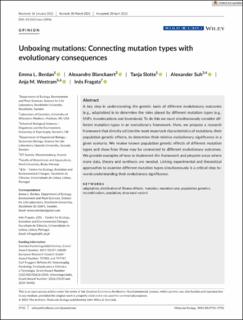| dc.contributor.author | Berdan, Emma L. | |
| dc.contributor.author | Blanckaert, Alexandre | |
| dc.contributor.author | Slotte, Tanja | |
| dc.contributor.author | Suh, Alexander | |
| dc.contributor.author | Westram, Anja Marie | |
| dc.contributor.author | Fragata, Inês | |
| dc.date.accessioned | 2022-07-11T09:16:43Z | |
| dc.date.available | 2022-07-11T09:16:43Z | |
| dc.date.created | 2021-09-23T17:30:37Z | |
| dc.date.issued | 2021 | |
| dc.identifier.citation | Berdan, E.L., Blanckaert, A., Slotte, T., Suh, A., Westram, A.M. & Fragata, I. (2021). Unboxing mutations: Connecting mutation types with evolutionary consequences.Molecular Ecology, 30(12), 2710-2723. doi: | en_US |
| dc.identifier.issn | 1365-294X | |
| dc.identifier.uri | https://hdl.handle.net/11250/3004503 | |
| dc.description.abstract | A key step in understanding the genetic basis of different evolutionary outcomes (e.g., adaptation) is to determine the roles played by different mutation types (e.g., SNPs, translocations and inversions). To do this we must simultaneously consider different mutation types in an evolutionary framework. Here, we propose a research framework that directly utilizes the most important characteristics of mutations, their population genetic effects, to determine their relative evolutionary significance in a given scenario. We review known population genetic effects of different mutation types and show how these may be connected to different evolutionary outcomes. We provide examples of how to implement this framework and pinpoint areas where more data, theory and synthesis are needed. Linking experimental and theoretical approaches to examine different mutation types simultaneously is a critical step towards understanding their evolutionary significance. | en_US |
| dc.language.iso | eng | en_US |
| dc.publisher | Wiley | en_US |
| dc.rights | Navngivelse-Ikkekommersiell 4.0 Internasjonal | * |
| dc.rights.uri | http://creativecommons.org/licenses/by-nc/4.0/deed.no | * |
| dc.title | Unboxing mutations : Connecting mutation types with evolutionary consequences | en_US |
| dc.title.alternative | Unboxing mutations: Connecting mutation types with evolutionary consequences | en_US |
| dc.type | Peer reviewed | en_US |
| dc.type | Journal article | en_US |
| dc.description.version | publishedVersion | en_US |
| dc.rights.holder | © 2021 The Authors | en_US |
| dc.subject.nsi | VDP::Matematikk og Naturvitenskap: 400::Basale biofag: 470::Molekylærbiologi: 473 | en_US |
| dc.subject.nsi | VDP::Matematikk og Naturvitenskap: 400::Basale biofag: 470::Biokjemi: 476 | en_US |
| dc.subject.nsi | VDP::Matematikk og Naturvitenskap: 400::Basale biofag: 470::Genetikk og genomikk: 474 | en_US |
| dc.source.pagenumber | 2710-2723 | en_US |
| dc.source.volume | 30 | en_US |
| dc.source.journal | Molecular Ecology | en_US |
| dc.source.issue | 12 | en_US |
| dc.identifier.doi | 10.1111/mec.15936 | |
| dc.identifier.cristin | 1937883 | |
| dc.relation.project | EC/H2020/757451 | en_US |
| dc.relation.project | EC/H2020/797747 | en_US |
| dc.relation.project | Vetenskapsrådet: 2019-04452 | en_US |
| dc.relation.project | Vetenskapsrådet: 2016-05139 | en_US |
| dc.relation.project | Andre: Svenska Forskningsrådet: 2017-01597 | en_US |
| dc.relation.project | Andre: Fundação para a Ciência e a Tecnologia: CEECIND/02616/2018 | en_US |

